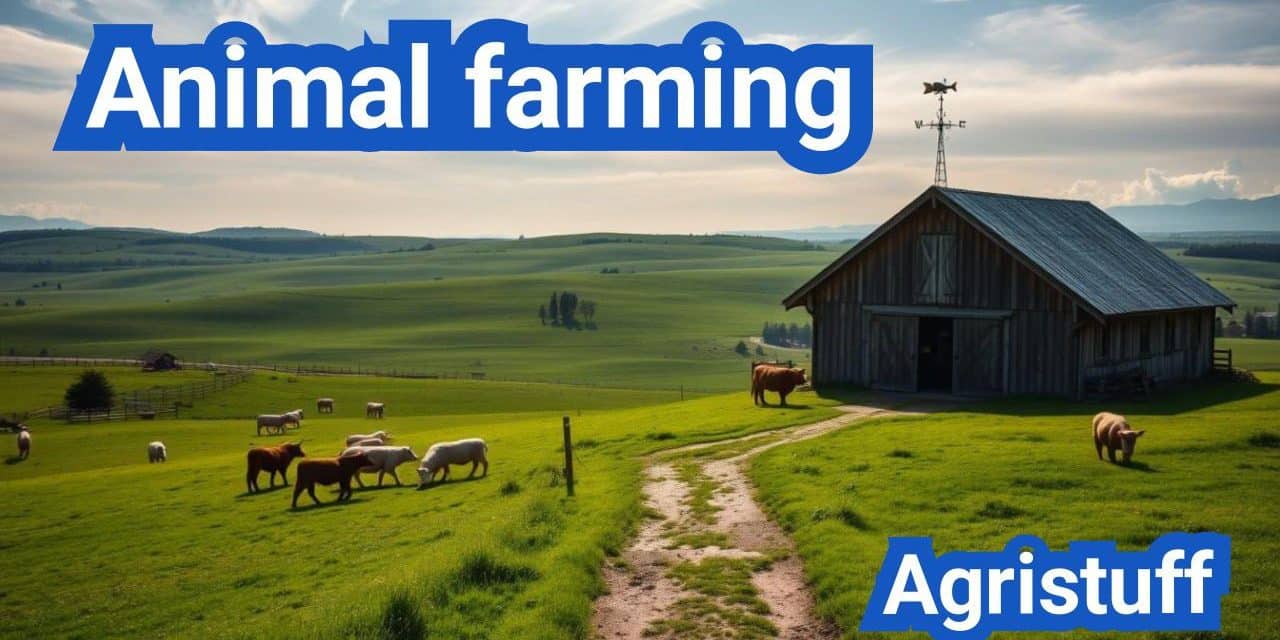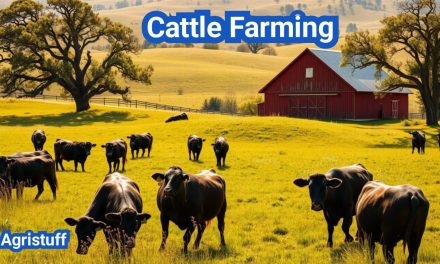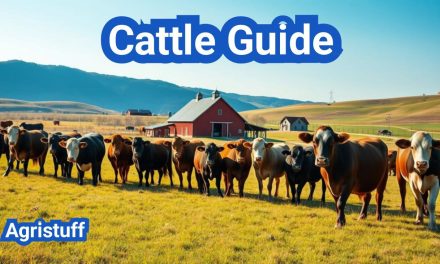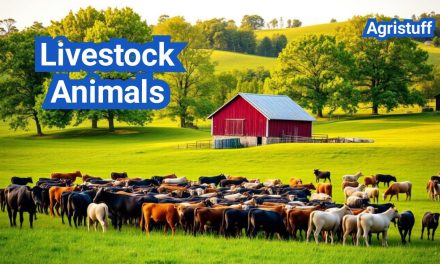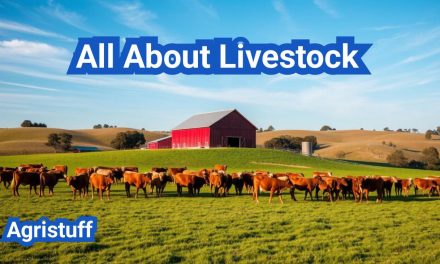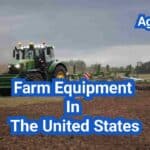Livestock farming is a vital part of the agricultural industry in the United States, providing a significant source of food and income for many communities.
The practice of animal husbandry involves the care and management of farm animals, including miniature cattle, poultry, and goats, to produce a variety of products such as meat, dairy, and eggs.
Factory farming is a common method used to maximize production while minimizing costs, but it has raised concerns about farm animal welfare.
Key Takeaways
- The importance of livestock farming in the USA.
- Various types of farming practices, including those for miniature cattle, poultry, and goats.
- The role of animal husbandry in farm animal care and management.
- Concerns surrounding factory farming and farm animal welfare.
- The impact of animal agriculture on the environment and communities.
What Is Animal Farming and Why Is It Important?
Animal husbandry, the care and management of farm animals, plays a crucial role in the global food system. It encompasses a wide range of practices and techniques used to raise animals for food, clothing, and other products.
The Definition and Scope of Animal Husbandry
Animal husbandry involves the daily care and management of farm animals, including feeding, breeding, and health management. The scope of animal husbandry is vast, covering various types of livestock such as cattle, pigs, sheep, goats, and poultry. Efficient animal husbandry practices are essential for ensuring the welfare of farm animals and maintaining a sustainable food system.
The History and Evolution of Livestock Production
Livestock production has a rich history that dates back to ancient times. The domestication of animals around 10,000 years ago marked the beginning of a new era in human history, enabling the development of settled agriculture and the growth of civilizations. Over time, livestock production has evolved significantly, with advances in breeding, nutrition, and health management. The development of new technologies and farming practices has transformed the livestock industry, making it more productive and efficient.
Economic Impact of Animal Agriculture in the USA
Animal agriculture is a significant contributor to the US economy. The industry supports millions of jobs and generates billions of dollars in revenue each year. According to recent data, there are around 250,000 farms in the US, with nearly 99 percent of farmed animals being raised on factory farms.
| Economic Indicator | Value |
|---|---|
| Number of Farms | 250,000 |
| Percentage of Factory Farmed Animals | 99% |
| Employment Opportunities | Millions |
The economic impact of animal agriculture in the USA is substantial, with the industry playing a vital role in the country’s food system and economy. As the demand for animal products continues to grow, the industry is likely to evolve further, with a focus on sustainability, animal welfare, and environmental stewardship.
Types of Animal Farming Systems

Animal farming encompasses a broad spectrum of practices, from extensive to intensive methods. The choice of farming system depends on various factors including land availability, climate, market demand, and the farmer’s resources and preferences.
Extensive vs. Intensive Farming Methods
Extensive farming involves raising animals over large areas with minimal infrastructure, allowing them to roam freely. This method is often associated with lower production costs but can result in lower productivity per acre. In contrast, intensive farming maximizes production by concentrating animals in smaller areas, often with advanced infrastructure and management practices.
Intensive farming can lead to higher yields but requires significant investment in facilities and animal care.
Free-Range and Pasture-Based Systems
Free-range and pasture-based systems prioritize animal welfare by providing access to outdoor areas. These systems are popular for producing high-quality meat and dairy products. As one farmer notes, “Our pasture-based system not only improves the welfare of our animals but also enhances the quality of our products.”
“The benefits of free-range systems extend beyond animal welfare to include environmental advantages and product quality.”
Factory Farming and Industrial Production
Factory farming, or industrial production, is characterized by large-scale operations that prioritize efficiency and cost-effectiveness. While this method can meet high demand and reduce costs, it has faced criticism regarding animal welfare and environmental impact.
Integrated Livestock-Crop Systems
Integrated livestock-crop systems combine the production of crops and animals on the same farm, promoting ecological interactions between them. This approach can enhance biodiversity, improve soil health, and increase overall farm productivity.
Getting Started with Animal Farming
Embarking on an animal farming journey necessitates careful consideration of several factors. To ensure a successful start, it’s crucial to assess your resources, understand legal obligations, and plan your venture meticulously.
Assessing Your Land and Resources
Before initiating your farm, evaluate your land’s suitability for animal farming. Consider factors such as soil quality, water availability, and climate conditions. A thorough land assessment will help determine the types of animals you can raise and the farming methods to adopt.
Understanding Legal Requirements and Permits
Familiarize yourself with local, state, and federal regulations governing animal farming. Obtain necessary permits and licenses to operate your farm legally. Compliance with animal welfare standards and environmental regulations is also crucial.
Creating a Business Plan for Your Farm
A comprehensive business plan is vital for the success of your farm. It should outline your goals, production costs, marketing strategies, and financial projections. A well-crafted business plan will help you secure funding and make informed decisions.
Essential Equipment and Infrastructure
Invest in necessary equipment and infrastructure, such as fencing, shelters, feeding systems, and waste management facilities. The type and quality of equipment will depend on the type of animals you’re raising and the scale of your operation.
| Equipment/Infrastructure | Description | Importance Level |
|---|---|---|
| Fencing | Boundary and paddock fencing for animal containment | High |
| Shelters | Providing protection from weather conditions | High |
| Feeding Systems | Automated or manual feeding equipment | Medium |
| Waste Management | Facilities for handling animal waste | High |
Cattle Farming Guide

Cattle farming encompasses a broad spectrum of farming methods and cattle breeds, offering diverse opportunities for farmers and livestock enthusiasts alike. Whether you’re interested in raising beef cattle for meat or dairy cows for milk, understanding the different aspects of cattle farming is crucial for success.
Popular Beef Cattle Breeds
Beef cattle breeds are selected based on factors like growth rate, meat quality, and climate adaptability. Some of the most popular breeds include Angus, known for their high-quality beef, and Hereford, which are hardy and easy to manage. Other notable breeds are Simmental and Charolais, both recognized for their rapid growth and lean meat production.
Dairy Cow Selection and Management
Dairy cow selection is critical for milk production. Breeds like Holstein are renowned for their high milk yield, while Jersey cows are prized for the rich quality of their milk. Effective dairy cow management involves regular milking, nutritional feeding, and health monitoring to ensure optimal productivity.
“The care of dairy cows is not just about milk production; it’s about creating a healthy environment that fosters well-being and productivity.” – Dairy Farming Expert
Miniature Cattle Breeds for Small Farms
For small farms or those new to cattle farming, miniature cattle breeds offer a viable option. Breeds like Miniature Hereford and Jersey are not only adorable but also require less space and feed compared to their full-sized counterparts. They are ideal for small-scale farming operations or hobby farms.
Raising Fluffy Cows: Highland and Other Specialty Breeds
Specialty breeds like Highland cattle are gaining popularity due to their unique appearance and hardiness. Known for their shaggy coats, Highland cattle are well-suited to harsh climates and require minimal maintenance. Other specialty breeds offer similar benefits, making them attractive options for farmers looking to diversify their livestock.
In conclusion, cattle farming is a diverse field with numerous breeds and farming methods to explore. By understanding the characteristics and needs of different cattle breeds, farmers can make informed decisions to enhance their farming operations.
Goat Farming Essentials
Goat farming, encompassing dairy, meat, and fiber production, is a significant aspect of modern agriculture. Raising goats can be a profitable venture, requiring careful management of resources such as land, labor, and feed. With the right approach, goat farming can provide a sustainable livelihood for farmers.
Dairy Goat Breeds and Management
Dairy goat breeds are known for their high milk production and are often used on farms for dairy products. Popular breeds include the Alpine, Saanen, and Toggenburg. Effective management of dairy goats involves providing high-quality feed, regular veterinary care, and proper milking practices.
- Provide a nutritious diet that includes a mix of hay, grains, and minerals.
- Ensure access to clean water at all times.
- Implement a regular milking schedule to maintain milk production.
Meat Goat Production
Meat goat production is another significant aspect of goat farming, with breeds like the Boer and Kiko being popular for their meat quality. Meat goat production requires careful selection of breeding stock, nutritional management, and health care.
- Select breeds that are well-suited to your climate and market demand.
- Provide adequate nutrition to support growth and development.
- Monitor health regularly to prevent disease.
Miniature and Pygmy Goats
Miniature and pygmy goats are gaining popularity on small farms due to their compact size and lower feed requirements. These goats are often kept as pets or used in small-scale farming operations. Their management requires attention to their specific nutritional and housing needs.
Goat Housing and Fencing Requirements
Proper housing and fencing are crucial for the success of goat farming. Goats require secure fencing to prevent escape and predation, as well as shelter from the elements. Housing should be well-ventilated and dry to maintain goat health.
- Use sturdy fencing materials, such as woven wire or electric fencing.
- Provide shelter that protects goats from wind, rain, and extreme temperatures.
- Ensure housing is clean and dry to reduce health risks.
In conclusion, goat farming is a multifaceted agricultural practice that requires careful planning and management. By understanding the different aspects of goat farming, including breed selection, nutrition, and housing, farmers can optimize their operations for success.
Sheep Farming Basics

The basics of sheep farming encompass a range of activities, from breed selection to flock management. Sheep farming is a significant aspect of animal agriculture, providing products such as wool, meat, and milk.
Wool and Meat Sheep Breeds
Sheep breeds are primarily classified into wool and meat types, with some breeds serving dual purposes. Wool breeds like Merino are renowned for their high-quality fleece, while meat breeds such as Suffolk are prized for their fast growth rates and muscular development.
| Breed Type | Characteristics | Primary Use |
|---|---|---|
| Merino | High-quality fleece, hardy | Wool |
| Suffolk | Fast growth rate, muscular | Meat |
| Dorset | Good mothering ability, adaptable | Meat/Wool |
Specialty Breeds
Some sheep breeds are considered specialty due to their unique characteristics or adaptability to specific environments. For example, the Jacob breed is known for its distinctive multi-colored fleece, while the Icelandic sheep is valued for its hardiness and ability to thrive in challenging climates.
Lambing and Flock Management
Lambing is a critical period in sheep farming, requiring careful management to ensure the health and survival of newborn lambs. Effective flock management involves monitoring the health of the flock, managing nutrition, and implementing breeding programs to improve the quality of the flock.
Key aspects of lambing and flock management include:
- Monitoring ewe health before and during lambing
- Providing adequate nutrition for ewes and lambs
- Implementing a breeding program to enhance flock quality
Successful Poultry Farming Strategies

Effective poultry farming strategies are crucial for maximizing production while ensuring animal welfare. Poultry farming encompasses a wide range of activities, from raising chickens for eggs and meat to breeding turkeys and ducks.
Chicken Breeds for Eggs and Meat
Selecting the right chicken breed is fundamental to the success of a poultry farm. For egg production, breeds like the Leghorn and Rhode Island Red are popular due to their high yield. For meat, broiler chickens such as the Cornish Cross are preferred for their rapid growth rate.
Some farms opt for dual-purpose breeds that provide both eggs and meat, offering a more diversified income stream. Examples include the Barred Plymouth Rock and the Australorp.
Turkey, Duck, and Other Poultry Options
Besides chickens, other poultry like turkeys and ducks are raised for meat. Turkeys are particularly popular during holidays, while ducks are valued for their meat and down feathers. Other birds like geese and quails are also raised on some farms.
| Poultry Type | Primary Use | Notable Breeds |
|---|---|---|
| Chicken | Eggs, Meat | Leghorn, Cornish Cross |
| Turkey | Meat | Narragansett, Broad-Breasted White |
| Duck | Meat, Down Feathers | Pekin, Khaki Campbell |
Housing and Equipment for Poultry
Proper housing is essential for the health and productivity of poultry. The housing should protect the birds from predators and extreme weather conditions. Ventilation, temperature control, and adequate space are critical factors.
Equipment such as feeders, drinkers, and egg collection systems must be designed to minimize waste and reduce labor. Automated systems can significantly improve efficiency.
Disease Prevention and Management
Disease prevention is a critical aspect of poultry farming. Implementing biosecurity measures such as vaccination programs, sanitation, and controlling access to the farm can significantly reduce the risk of disease outbreaks.
“Biosecurity is not just about keeping diseases out; it’s also about maintaining a healthy environment for the birds.” – Poultry Farming Expert
Regular monitoring of the flock’s health and prompt action in case of any illness are crucial. Farmers should work closely with veterinarians to develop effective health management plans.
Alternative Livestock Options

Alternative livestock farming offers a range of possibilities for farmers to expand their businesses. By diversifying farm operations, farmers can tap into new markets and revenue streams.
Alpaca Farming Basics
Alpaca farming is gaining popularity due to the high demand for their soft fleece. Alpacas are relatively low-maintenance animals, requiring less space and food compared to traditional livestock. They are known for their gentle nature and can be integrated into existing farm operations.
Rabbit Production
Rabbit farming is another alternative livestock option that can be profitable. Rabbits are fast breeders, and their meat is considered a healthy alternative to traditional red meat. Effective rabbit production requires careful management of breeding, nutrition, and health.
| Livestock | Initial Investment | Maintenance | Market Demand |
|---|---|---|---|
| Alpacas | High | Low | High for fleece |
| Rabbits | Low | Medium | High for meat |
| Beekeeping | Medium | Low | High for honey |
Beekeeping as Complementary Enterprise
Beekeeping can complement alternative livestock farming by providing an additional income stream through honey production. Bees also play a crucial role in pollinating crops, enhancing overall farm productivity.
In conclusion, exploring alternative livestock options such as alpaca farming, rabbit production, and beekeeping can provide farmers with new opportunities for growth and diversification.
Modern Animal Farming Technologies

Technological advancements are transforming the landscape of animal farming, enhancing productivity and welfare. The integration of modern technologies is revolutionizing traditional farming practices, making them more efficient and sustainable.
Precision Livestock Farming
Precision livestock farming involves the use of advanced technology to monitor and manage individual animals or groups. This approach allows farmers to make data-driven decisions, improving overall farm productivity. Precision livestock farming technologies include sensors, GPS tracking, and data analytics tools.
Automated Feeding and Monitoring Systems
Automated feeding systems ensure that animals receive the right amount of feed at the right time, optimizing growth rates and reducing waste. Monitoring systems, including health monitoring and behavior tracking, enable early detection of health issues, allowing for timely interventions.
Breeding Technologies and Genetics
Advances in breeding technologies and genetics are enabling farmers to improve the quality and productivity of their livestock. Techniques such as genetic selection and genome editing are being used to breed animals with desirable traits, such as improved disease resistance and faster growth rates.
Digital Record-Keeping and Farm Management Software
Digital record-keeping and farm management software are crucial for modern animal farming. These tools help farmers manage complex data, including feeding schedules, health records, and breeding programs. By having accurate and accessible records, farmers can make informed decisions and improve farm efficiency.
The adoption of these modern technologies is not only enhancing the productivity and sustainability of animal farming but also improving animal welfare. As the global demand for animal products continues to rise, the role of technology in meeting this demand sustainably will become increasingly important.
Sustainable Animal Farming Practices

Implementing sustainable practices in animal farming not only benefits the environment but also enhances farm health and productivity. As the global demand for food continues to rise, adopting sustainable methods is crucial for ensuring a viable future for agriculture.
Rotational Grazing Systems
Rotational grazing involves moving livestock to different areas of pasture to allow the land to recover. This practice helps maintain soil health, reduces erosion, and promotes biodiversity. By rotating grazing areas, farmers can also improve the quality of their pastures, leading to healthier livestock.
Reducing Environmental Impact
Sustainable animal farming practices aim to minimize the environmental footprint of agricultural activities. Strategies include reducing water usage, managing waste effectively, and minimizing the use of chemicals. By adopting these practices, farmers can significantly reduce their environmental impact.
Organic Livestock Production
Organic livestock production focuses on raising animals without the use of synthetic fertilizers, pesticides, or genetically modified organisms (GMOs). This approach promotes animal welfare and produces high-quality products. Organic farming methods also contribute to maintaining ecological balance and biodiversity.
Regenerative Agriculture with Livestock
Regenerative agriculture involves practices that enhance ecosystem services, improve soil health, and promote biodiversity. Integrating livestock into regenerative agriculture systems can enhance these benefits. By using techniques like rotational grazing, farmers can improve soil carbon sequestration, reduce greenhouse gas emissions, and promote ecosystem health.
The benefits of sustainable animal farming practices are numerous, including improved environmental health, enhanced farm productivity, and better animal welfare. By adopting these practices, farmers can contribute to a more sustainable food system.
- Increased biodiversity
- Improved soil health
- Reduced environmental impact
- Enhanced animal welfare
- Better quality products
By embracing sustainable animal farming practices, farmers can ensure a healthier planet and a more sustainable future for generations to come.
Ethical Animal Farming and Welfare Considerations

As awareness about animal welfare grows, so does the importance of implementing ethical farming practices in the agricultural industry. Ethical animal farming prioritizes the well-being of farm animals, ensuring that they are treated with respect and care.
Animal Welfare Standards
Animal welfare standards are guidelines that ensure farm animals are treated humanely. These standards cover various aspects, including living conditions, feeding practices, and handling procedures. Implementing these standards is crucial for maintaining ethical farming practices.
Humane Handling Practices
Humane handling practices are essential for minimizing stress and injury to farm animals. Techniques such as gentle handling, avoiding overcrowding, and providing adequate space contribute to better animal welfare. Farmers can adopt these practices to improve the overall well-being of their animals.
Certification Programs for Ethical Farming
Certification programs, such as Certified Humane or Animal Welfare Approved, provide a framework for farmers to demonstrate their commitment to ethical farming practices. These programs involve inspections and adherence to strict standards, ensuring that farms meet high welfare requirements.
Balancing Productivity and Animal Well-being
One of the challenges in ethical animal farming is balancing productivity with animal welfare. While maximizing output is important for farm profitability, it should not come at the expense of animal well-being. Strategies such as improving living conditions and adopting humane handling practices can help achieve this balance.
| Certification Program | Standards | Benefits |
|---|---|---|
| Certified Humane | High welfare standards for living conditions and handling | Better market access, consumer trust |
| Animal Welfare Approved | Rigorous standards for animal welfare and environmental sustainability | Premium prices, improved farm practices |
Marketing and Selling Your Farm Products

Farmers can increase their profits by implementing direct marketing strategies and creating value-added products. Direct marketing allows farmers to connect with consumers directly, potentially increasing their profit margins by eliminating intermediaries.
Direct Marketing Strategies
Direct marketing involves selling products directly to consumers through various channels such as farmers’ markets, roadside stands, and community-supported agriculture (CSA) programs. These strategies help build a loyal customer base and provide an opportunity to educate consumers about the products.
- Farmers’ markets
- Roadside stands
- Community-supported agriculture (CSA) programs
- Online sales platforms
Value-Added Products
Creating value-added products is another effective way to increase profitability. This involves processing raw farm products into items like jams, honey, or cheese, which can command higher prices than their raw counterparts.
Examples include:
- Jams and preserves
- Honey and beeswax products
- Artisanal cheeses
Building Your Farm Brand
Farm branding is crucial for differentiating your products in a competitive market. A strong brand identity can help build customer loyalty and justify premium pricing.
Key elements of farm branding include:
- A unique logo
- Consistent packaging
- Storytelling about your farm’s history and practices
Online and Local Sales Channels
Utilizing both online and local sales channels can significantly expand your market reach. Online platforms include e-commerce websites and social media, while local channels encompass farmers’ markets and local grocery stores.
By diversifying your sales channels and implementing effective marketing strategies, you can increase your farm’s visibility and profitability.
Finally: Building a Successful and Sustainable Animal Farm
Creating a thriving animal farm requires a combination of careful planning, effective management, and a commitment to animal welfare and environmental sustainability. By understanding the different types of animal farming systems, selecting the right livestock, and implementing modern technologies, farmers can improve productivity while reducing their environmental footprint.
Successful farming practices involve not only maximizing profits but also ensuring the long-term viability of the farm. This includes adopting sustainable farming methods, such as rotational grazing and regenerative agriculture, which help maintain soil health, conserve water, and promote biodiversity.
Effective animal farm management is crucial for achieving these goals. By prioritizing animal welfare, implementing efficient feeding and breeding programs, and leveraging digital tools for record-keeping and monitoring, farmers can create a more sustainable and profitable operation. As the demand for sustainable and responsibly sourced products continues to grow, building a successful and sustainable animal farm is both a business opportunity and a responsibility to the environment and consumers.
FAQ
What is animal farming, and why is it important?
Animal farming, also known as livestock farming, is the practice of raising animals for various products such as meat, dairy, and wool. It is a vital part of agriculture, providing food, income, and employment for millions of people worldwide.
What are the different types of animal farming systems?
There are several types of animal farming systems, including extensive and intensive farming methods, free-range and pasture-based systems, factory farming, and integrated livestock-crop systems. Each system has its benefits and challenges.
How do I start an animal farm?
To start an animal farm, you need to assess your land and resources, understand legal requirements and permits, create a business plan, and acquire essential equipment and infrastructure.
What are the most popular beef cattle breeds?
Some of the most popular beef cattle breeds include Hereford, Angus, and Brahman. These breeds are known for their high-quality meat and are often used in commercial beef production.
What are the benefits of rotational grazing systems?
Rotational grazing systems involve moving animals to different grazing areas to promote soil health, reduce erosion, and increase biodiversity. This practice can improve pasture productivity and reduce environmental impact.
What is precision livestock farming?
Precision livestock farming involves using technology, such as automated feeding and monitoring systems, to improve the efficiency and productivity of animal farming. This approach can help reduce costs, improve animal welfare, and promote sustainability.
How can I market and sell my farm products?
You can market and sell your farm products through direct marketing strategies, such as farmers’ markets and community-supported agriculture (CSA) programs, or by creating value-added products and selling them online or through local sales channels.
What are the key considerations for animal welfare in farming?
Key considerations for animal welfare in farming include providing adequate housing, nutrition, and healthcare, as well as handling animals humanely and minimizing stress. Certification programs, such as those offered by the American Humane Association, can help promote animal welfare standards.
What is regenerative agriculture with livestock?
Regenerative agriculture with livestock involves using grazing animals to promote soil health, biodiversity, and ecosystem services. This approach can help sequester carbon, improve water quality, and promote ecosystem resilience.
What are the benefits of alternative livestock options, such as alpaca farming?
Alternative livestock options, such as alpaca farming, can provide a unique opportunity for farmers to diversify their operations and promote sustainability. Alpacas are known for their soft fiber, which can be sold to textile manufacturers, and their gentle disposition, which makes them a good choice for small farms.
Conclusion of: Animal farming
Animal farming is an essential pillar of human civilization, playing a pivotal role in food security, economic stability, and cultural traditions worldwide. Known also as livestock farming, animal farming involves the breeding, rearing, and management of animals to provide food, fiber, and other essential products. From small family farms to large-scale industrial operations, animal farming shapes the way we produce food, clothing, and even energy.
In this article, we’ll explore what animal farming entails, its various types, benefits, challenges, modern technologies, sustainability practices, and much more, to provide a comprehensive understanding of animal farming.
What is Animal Farming?
Animal farming is the systematic process of raising domesticated animals primarily for the production of meat, milk, eggs, wool, leather, and other commodities. It includes livestock management and husbandry practices designed to optimize animal health, productivity, and welfare.
Historically, animal farming started thousands of years ago when early human communities transitioned from hunting and gathering to agriculture-based lifestyles. This agricultural revolution significantly contributed to human settlements and societal growth.
A clear understanding of animal farming involves exploring different species, including cattle, poultry, pigs, sheep, and goats, each managed uniquely based on their specific biological and economic needs. FAO Livestock Systems
Types of Animal Farming
Animal farming can broadly be categorized based on animal types, production methods, and scale of operations. The following are the major types:
- Dairy Farming: Dairy farming primarily involves raising cows, goats, or sheep to produce milk and dairy products such as cheese, butter, and yogurt. Dairy farming is an essential part of the agricultural economy, particularly in the USA. USDA Dairy Sector
- Poultry Farming: Poultry farming focuses on raising domesticated birds like chickens, ducks, turkeys, and geese for their meat and eggs. It’s one of the fastest-growing sectors due to its efficiency and high nutritional value of products. USDA Poultry Information
- Beef Farming: Beef farming involves the breeding and raising of cattle for meat production. It typically employs pasture-based systems, although intensive feedlots are also common, especially in the USA. NCBA Beef Production
- Swine Farming: Swine or pig farming is the raising of pigs primarily for pork products. It involves different systems including intensive indoor farming and free-range outdoor farming. USDA Swine Farming
- Sheep and Goat Farming: Sheep farming primarily targets wool and meat production, while goats are raised for milk, meat, and fiber. Both species are adaptable and commonly farmed worldwide. AGMRC Sheep and Goats
Historical Overview of Animal Farming
The roots of animal farming trace back more than 10,000 years when humans began domesticating animals in regions such as the Fertile Crescent. Initial domestications included sheep, goats, cattle, pigs, and poultry.
Throughout history, animal farming advanced through innovations such as selective breeding, mechanization, and improved veterinary practices. The industrial revolution significantly impacted animal farming through mechanized equipment and better management practices, enhancing productivity tremendously. National Geographic History of Agriculture
Modern Animal Farming Techniques
Today, modern animal farming incorporates advanced technologies and practices aiming for efficiency, animal welfare, and sustainability.
- Precision Animal Farming: Utilizes technology like GPS, sensors, and data analytics to optimize animal management, feeding, health monitoring, and productivity.
- Automated Systems: Technologies like robotic milking machines, automated feeding systems, and environmental control systems increase operational efficiency and animal comfort. Penn State Livestock Technology
- Genetic Enhancement: Genetic improvements through selective breeding and genomic technologies enhance disease resistance, productivity, and adaptability to environmental stresses.
Benefits of Animal Farming
Animal farming offers substantial benefits, crucial to human welfare and economic prosperity:
- Food Security: Provides nutritious food like meat, dairy, and eggs, essential for human diets globally.
- Economic Stability: Contributes significantly to local, national, and global economies, creating employment opportunities and supporting rural livelihoods.
- Utilization of Resources: Converts non-arable land and agricultural by-products into valuable protein-rich foods, optimizing resource usage. Economic Impact of Animal Farming
Challenges of Animal Farming
Despite its benefits, animal farming faces several contemporary challenges:
- Environmental Concerns: Issues like greenhouse gas emissions, water usage, and land degradation are significant environmental challenges.
- Animal Welfare: Ensuring ethical and humane treatment of animals is increasingly a societal concern, prompting changes in farming practices.
- Disease Control: Livestock diseases pose significant economic and public health risks, requiring robust disease control and biosecurity measures. Animal Welfare Concerns
- Resource Management: The intensive nature of animal farming demands substantial amounts of water, feed, and energy, presenting sustainability challenges.
Sustainability in Animal Farming
Sustainable practices in animal farming seek to balance productivity with ecological responsibility:
- Organic Animal Farming: Organic methods focus on natural feed, reduced chemical use, and high standards for animal welfare and environmental sustainability. USDA Organic Farming
- Regenerative Farming: Incorporates techniques like rotational grazing, cover cropping, and holistic management to regenerate soil health and ecosystem services.
- Renewable Energy Integration: Utilizes renewable energy such as solar, wind, and biogas to reduce reliance on fossil fuels and lower environmental impact.
The Future of Animal Farming
Future trends in animal farming point towards enhanced technological integration, greater focus on sustainability, and adaptation to climate change:
- Cellular Agriculture: Developing cultured meat and dairy products to reduce environmental and ethical impacts of traditional animal farming.
- Enhanced Precision Farming: Further integration of artificial intelligence (AI), IoT, and robotics to enhance animal health monitoring and management.
- Circular Economy Approaches: Encouraging waste recycling and reuse, minimizing environmental impacts, and enhancing sustainability. Future Farming Innovations
Final Thought
Animal farming is a cornerstone of agriculture, significantly impacting human diets, economies, and environments. While challenges persist, ongoing innovations and sustainable practices offer viable pathways to improve animal welfare, enhance environmental responsibility, and ensure the continued success and relevance of animal farming globally. Embracing such advancements will undoubtedly shape the future of animal farming positively.

